

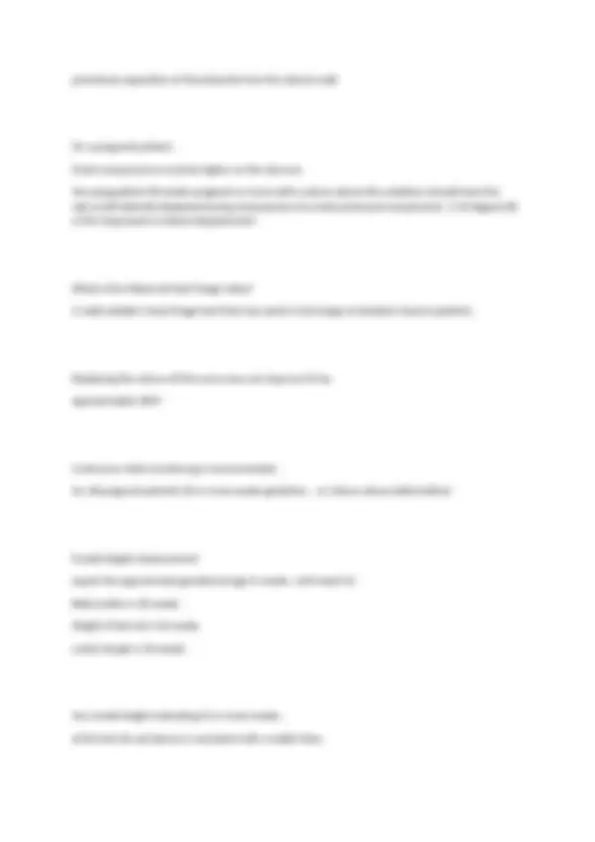
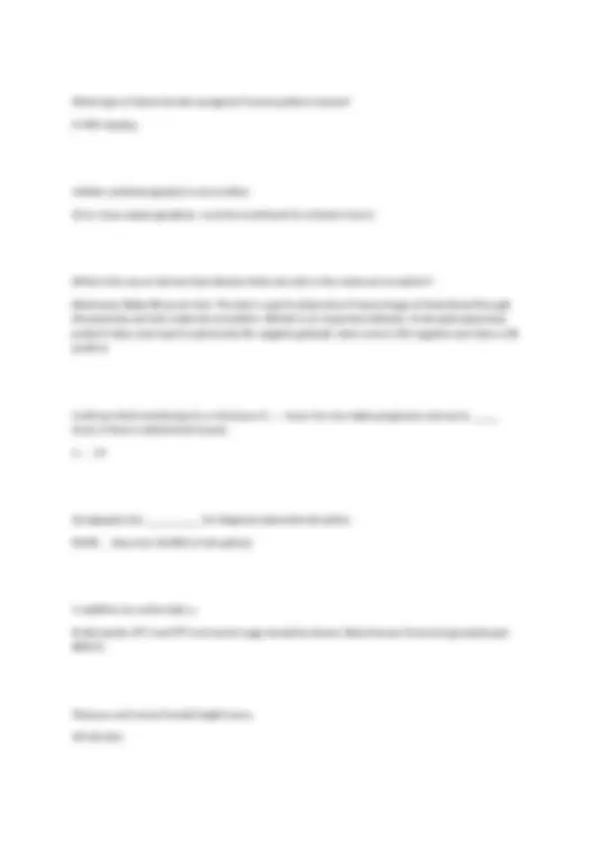

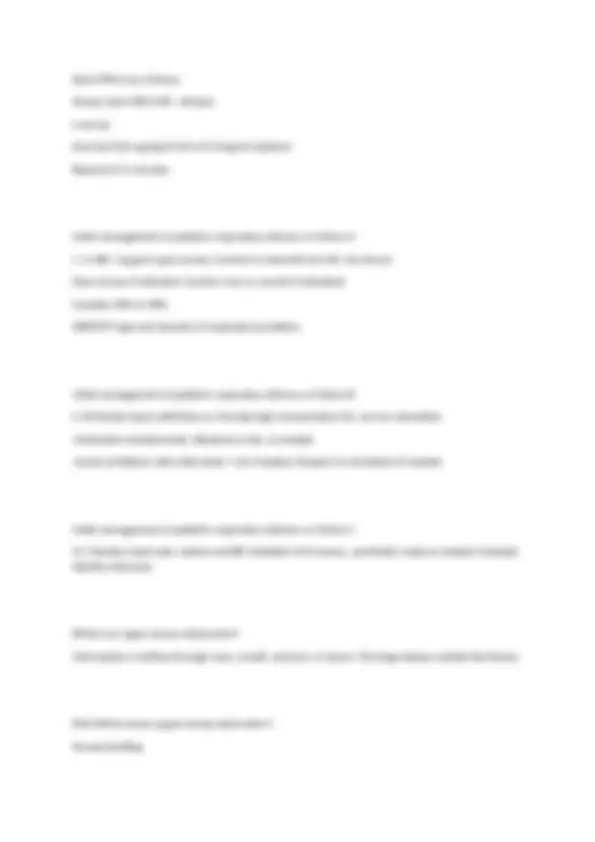
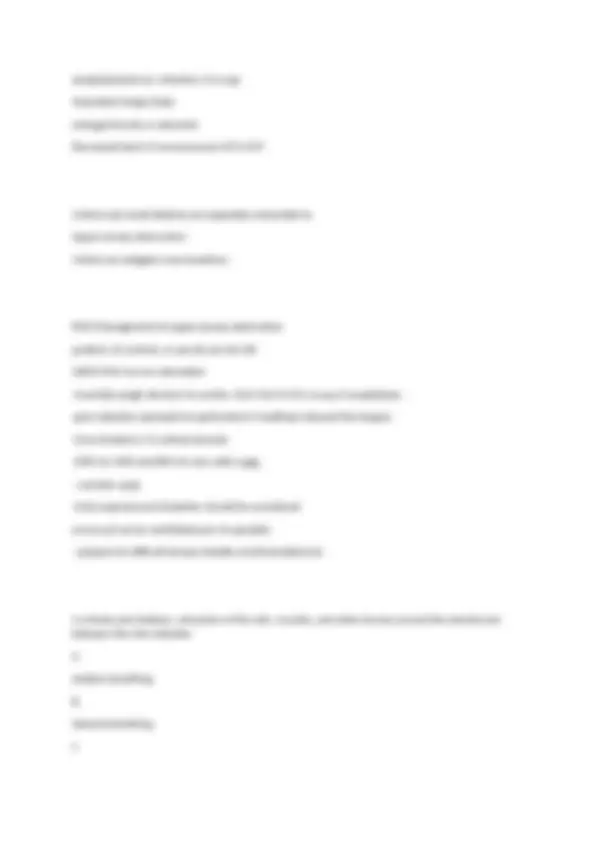



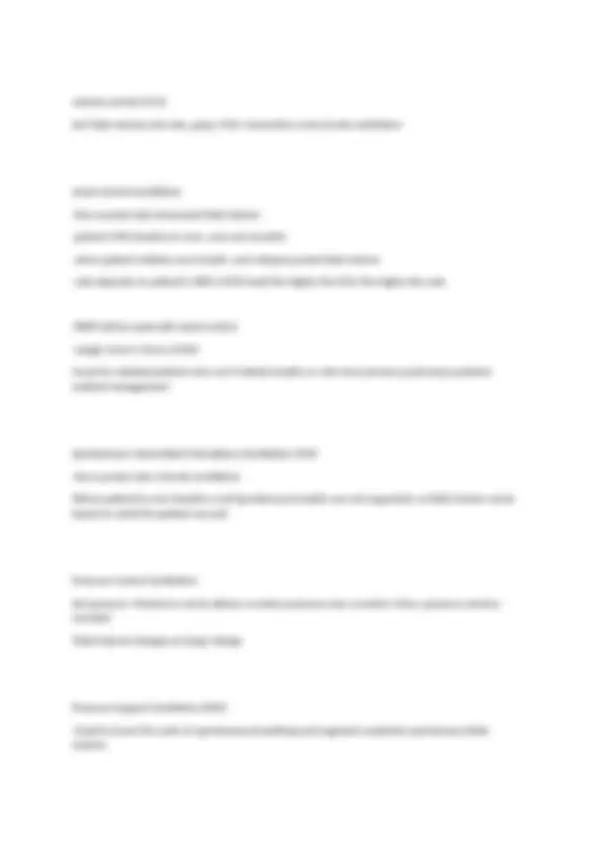



Study with the several resources on Docsity

Earn points by helping other students or get them with a premium plan


Prepare for your exams
Study with the several resources on Docsity

Earn points to download
Earn points by helping other students or get them with a premium plan
Community
Ask the community for help and clear up your study doubts
Discover the best universities in your country according to Docsity users
Free resources
Download our free guides on studying techniques, anxiety management strategies, and thesis advice from Docsity tutors
Air Methods Critical Care exam 200 Questions and Answers
Typology: Exams
1 / 19

This page cannot be seen from the preview
Don't miss anything!












What is the most reliable method of confirming and montioring correct placement of an ET tube? Continuous waveform capnography The upper airway consists of... Nose, Mouth, Jaw, Oral Cavity, Pharynx, and Larynx No gas exchange occurs here __________, it's called ____________. Nose to terminal bronchioles, anatomical dead space. (2ml/kg of inspired tidal volume) They conduct airflow towards gas exchange units. Crycothyroid membrane between thyroid and cricoid, avascular structure that connects the thyroid and cricoid cartilage. Site of CRiCOTHYROTOMY- an emergency opening of the airway. A PaCO2 greater than 45 mmHg indicates: A. Metabolic acidosis. B. Metabolic alkalosis. C. Respiratory acidosis. D. Respiratory alkalosis. C. Respiratory acidosis PaCO2 normal range 35-45 mm Hg Less than 35 likely means hyperventilation
Tracheal deviation AWAY from the affected side, decreased breath sounds, and hyperresonance... What's happening? Tension pneumothorax In a tension pneumothorax tracheal deviation goes in what direction? AWAY from affected side. Normal mean pulmonary artery pressure 10-20 mmHg Pulmonary hypertension is a mean PA pressure greater than... (PAm) greater than 20 Primary pulmonary hypertension Idiopathic genetic disorder caused by abnormal structure of the pulmonary blood vessels Name three causes of secondary pulmonary hypertension..
premature separation of the placenta from the uterine wall On a pregnant patient... Chest compressions must be higher on the sternum. Any preg patient 20 weeks pregnant or more with a uterus above the umbilicus should have the uterus left laterally displaced during compressions to avoid aortocaval compression. A 15 degree tilt of the long board or lateral displacement. What is the Maternal Fetal Triage Index? A valid reliable 5 level triage tool that may assist in the triage of obstetric trauma patients. Displacing the uterus off the vena cava can improve CO by approximately 30%! Continuous fetal monitoring is recommended... for all pregnant patients 20 or more weeks gestation... or (uterus above belly button). Fundal height measurement equals the approximate gestational age in weeks, until week 32. Belly button is 20 weeks Height of last rib is 26 weeks costal margin is 36 weeks Any fundal height indicating 23 or more weeks... at the last rib and above is consistent with a viable fetus.
What type of blood should a pregnant trauma patient receive? O-NEG baybay. Initiate cardiotocography in any mother 20 or more weeks gestation, must be monitored for at least 6 hours. What is the serum lab test that detects fetal red cells in the maternal circulation? Kleinhauer Bette KB serum test. This lab is used to determine if hemorrhage of fetal blood through the placenta and into maternal circulation. KB test is an important detector of abruptio placentae, preterm labor and need to administer Rh negative globulin when mom is Rh negative and fetus is Rh positive. Continue fetal monitoring for a minimum of ---- hours for any viable pregnancy and up to _____ hours if there is abdominal trauma 6..... 24 Sonography has __________ for diagnosis placental abruption, POOR.... they miss 50-80% of abruptions. In addition to routine labs a Prothrombin (PT ) and PTT and serial coags should be drawn. Beta Human Chorionic gonadotropin (BHCG) Measure and record fundal height every 30 minutes.
EKG findings more -St elevations > 1mm in Limb leads: 1, II, III, avF, avL -St elevations > 2mm in precordial leads (v1-v6) AND/OR -NEW LBBB Contiguous leads with reciprocal changes in opposite leads First degree Heart Block EKG AV block Prolonged PR Interval greater than 120-200 ms second degree heart block type 1 Wenkebach AV block in which occasional electrical impulses from the SA node fail to be conducted to the ventricles. PR interval progressively lengthens greater than 120-200ms + dropped beats. Maternal cardiopulmonary arrest...If any moribund patient is 24 weeks or more perimortem c section must be considered. AHA recommends c section initiation within... 4 minutes... delivery with in 5 minutes of any unsuccessful maternal resuscitative attempts. Second Degree Heart Block (Mobitz II) = Damage AT av node - moderate
5-10 mcg per minute Titrate by 10 mcg max dose 300 mcg per minute How do you mix epi? Mix 1 mg in 1 L NS or D5W or LR for a concentration of 1 mcg/ ml What's the epi dose for hypotension s/p arrest? 0.1 - 0.5 mcg/kg/min What is the epi dose for anaphylaxis? Pediatric Epinephrine dose PALS 2020 update AHA 2020 BASIC BP Diastolic BP of at least 25mmhg in infants and at least 35 mmhm in children correlates with better outcomes. PALS Brady with a pulse Assess airway, breathing, mental status Most common cause is hypoxia! could also be hypothermia and or medications. s/s of shock? AMS? hypotensive?
(anaphylactoid rx) ,Infection r/t croup Aspirated foreign body enlarged tonsils or adenoids Decreased level of consciousness GCS of 8? Infants and small children are especially vulnerable to Upper airway obstruction. Infants are obligate nose breathers. PALS Management of upper airway obstruction position of comfort, or jaw thrust chin lift 100% FIO2 via non rebreather -Carefully weigh decision to suction. Don't do it if it's croup of anaphylaxis. -give nebulizer epinephrine particularly if swelling is beyond the tongue. -Give inhaled or IV cortical steroids -OPA for AMS and NPA for ams with a gag.
see-saw breathing. D. normal breathing. PALS Management of upper airway obstruction caused by croup. PALS Management of Anaphylaxis In addition to ABC....
-Bipap -If refractory hypoxemia intubate. Epi Dose, Flight nurse trick 0.1ML/kg no matter what concentration according to Bill. PALS Defibrillation dose 2 J/kg PALS Cardioversion dose 0.5-1 J/KG PALS Calcium Dose & Indication Only for known/suspected hypocalcemia 20 mg/kg Calcium Chloride SLOW IV push PALS Increased ICP Cushings Triad Caused by increased ICP and impending herniation. -Irregular Breathing -Hypertension -Tachycardia In adults it's bradycardia Hyperventilate the patient to prevent further increases in ICP
-hypertonic saline, Osmotic agents (dose?) -Treat pain and agitation aggressively once airway is established. -Avoid hyperthermia PALS management of respiratory distress due to poisoning -Support airway -give antidote -call poison control Ventilation Management a Tidal volume is 5-7mL/Kg aprox. 500ml for an adult
hemodynamic changes in Cardiogenic shock SBP (Down) SVR (UP) CVP (UP) CO (Down) PAP (UP) Wedge (UP) PVR (UP) Coags (PT/INR/PTT) PT 11-14s PTT (20-40 sec) heparin INR (0.9-1.2) Coumadin Platelets : 150-450k
70-110 mg/dL Cr (Creatinine) 0.6-1.3 mg/dL Systemic Vascular Resistance (SVR) the force opposing the movement of blood within the blood vessels [(MAP-CVP) / CO] x Normal: 750-1600 dynes/sec SVR Formula & Normal (MAP - CVP / ) x 80 Normal 750-1600 dynes/sec hemodynamic changes in Hypovolemic hemorrhagic shock HR Increased SBP Decreased SVR Increased CVP Decreased Hemodynamics of septic shock -CO/CI; INCREASED -RAP/PAP/PAOP; decreased -SVR; decreased -SVO2; INCREASED
Cl (Cloride) 95- Acute Respiratory Failure blood gases Calcium Ca2+ 8- Hemoglobin (male and female) Male: 14-18 g/dL Female: 12-16 g/dL Hemotocrit percentage of RBC in a volume of blood Males 45-52% Females 37-48% Trick: it's the HGb x 3 Glasgow Coma Scale (GCS) 3-15 with 15=good and 3=bad Brain injury GCS: Minor 13- Moderate 9-12 Asses ability to protect airway Severe 3-
-PSV is often used with SIMV and CPAP, or as a stand alone mode to facilitate weaning -Psv should increase spontaneous Vt, decrease respiratory rate and decrease WOB -PSV decreases work of breathing that is superimposed by the artificial airway Stroke Volume (SV) The volume of blood pumped forward with each ventricular contraction. EDV-ESV= SV 50-100 cc per beat basically Males: 65- Females: 66- See 99 more You can also click the terms or definitions to blur or reveal them Choose a study mode